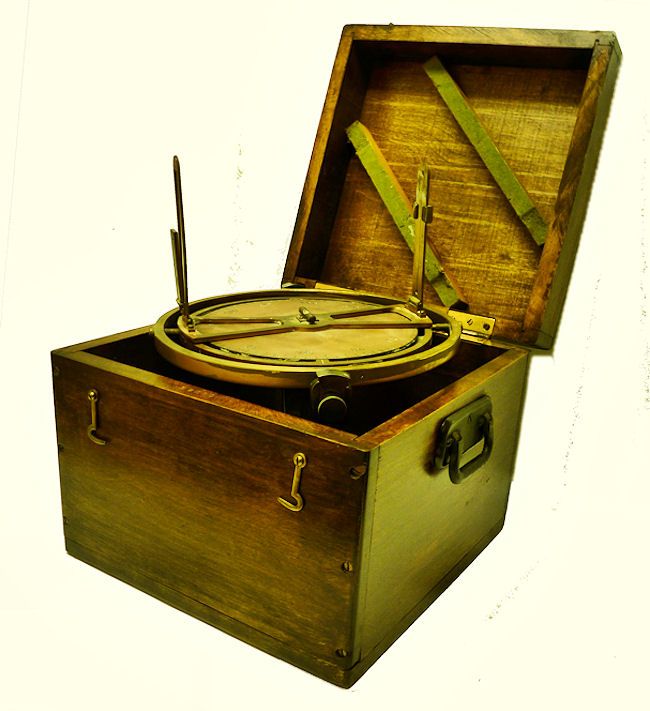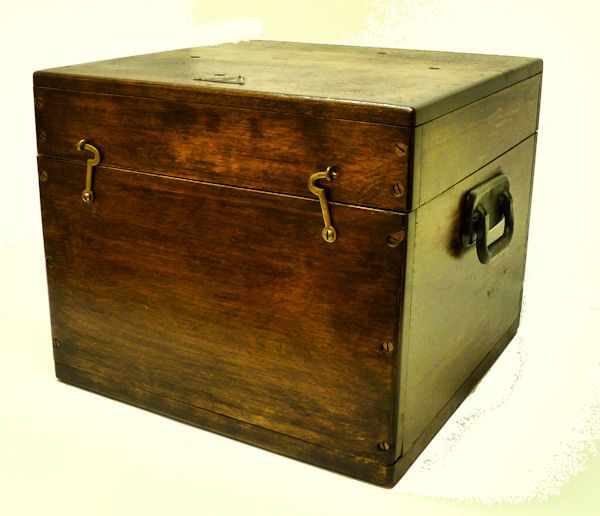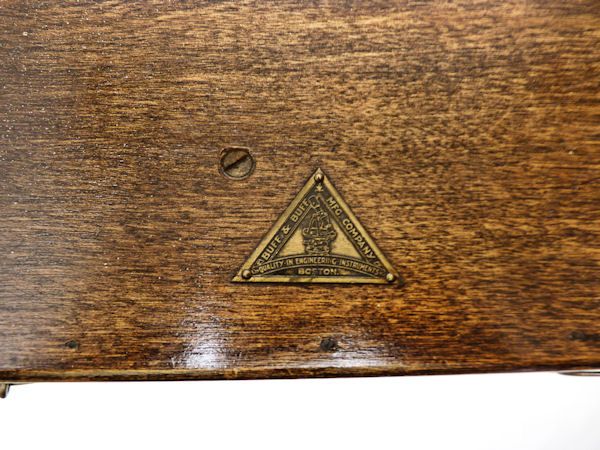CASED PELORUS
by
BUFF & BUFF,
BOSTON
 < GIANT BRONZE PELORUS WW II<
< GIANT BRONZE PELORUS WW II<
A large ships’ pelorus in a case
PRESENTED is a giant
of a pelorus made by old-line instrument maker, Buff & Buff, Boston around the time of WW II though it could date from
WW I. It has the number, 12688 on its dial. The maker’s name is imprinted on the center of the dial and appears on a triangular
tag on the box. It is housed inside a large wood case
Pelorus was used to take relative bearings in determining a
vessel’s position. These bearings are then related to the ship’s heading and the compass bearing of the object sighted is
determined. Other applications are listed below:
>Determine anchor security Determine relative bearings change Predict crossing situations Plot offshore fixes Determine compass error by celestial body DIMENSIONS: Diameter of outer ring 11 1/2 inches
Diameter of compass rose 8 1/2 inches
CASE: 13 1/4“ square x 11 1/4” H Weight 20 pounds
The word pelorus comes from the name of the guide who directed Hannibal’s
army from Carthage to Rome in 218 B.C.
 This example
This example
consists of a compass rose with North in the form of a simple arrow with tail as the zero indicator. The outer ring is enumerated
with bold numbers every 30 degrees with intermediate hash marks every 5 degrees which is further subdivided into 1 degree increments.
On the inner circle, the cardinal points have directional coordinates “lettered”, N, S, E, & W. that are further subdivided
by NE, SE, SW, NW markings which divide the circle into 32 points, each of 11 1/4 degrees.
 Shown with the sighting vanes down The bronze compass rose is set inside a bronze ring on gimbals
Shown with the sighting vanes down The bronze compass rose is set inside a bronze ring on gimbals
with a heavy lead weight below so that it remains level during the ship’s movements. There are two sighting vanes which move
together. The viewer’s vane has a sun shade attached. The forward vane had a hairline thread that is missing that is lined
up on the body. It also has a filter to reduce the brightness of the sun when taking amplitude sights. It is designed to be
used when mounted on a pipe stand on the bridge wings or may be used while in its wood case. <  Large size case The two sighting vanes are aimed at a terrestrial object
Large size case The two sighting vanes are aimed at a terrestrial object
with the bearing read off the compass card. These bearings are simultaneously compared to the vessel’s compass heading which
then gives the compass bearing to the object. Appropriate adjustment is made for compass error. Bearings of two objects, taken
sequentially, will fix the vessel’s position. Similar observations of a rising or setting sun when on the prime vertical allow
for determining compass error.
CONDITION: Except for some minor stains on the case and some of the minor blemishes, it is in very good condition. The
pelorus shows use at sea but is complete and usable. A sighing thread in the front vane is missing. There is a level at the
center point of the dial.  Maker’s tag
Maker’s tag
 Showing sighting vanes BUFF & BUFF MANUFACTURING
Showing sighting vanes BUFF & BUFF MANUFACTURING
COMPANY was started by George Louis Buff in 1898 with his son, Louis, after the elder Buff dissolved his previous
business Buff & Berger. They were a manufacturer of precision engineering instruments, primarily surveying transits and
theodolites, but during the course of WW, I and WW II manufacture navigation instruments, including sextants for the Navy.
In various forms, they survived until around 1980 when they went out of business.Here is a
piece of old seagoing gear in good condition. It is a good selection for any collection or for use it at sea.
